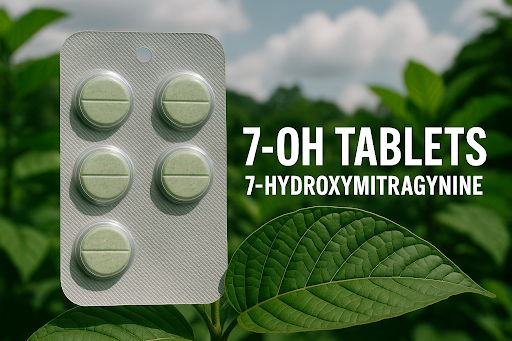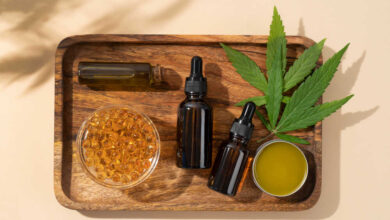Kratom 7-OH: Why High-Potency Kratom Extracts Deserve a Closer Look

Natural doesn’t always mean safe. That’s something more people are starting to realize when it comes to kratom and especially its stronger forms like 7-OH. Originally praised for its potential to ease discomfort and boost mood, kratom has grown in popularity across wellness communities. But the rise of high-potency kratom extracts like 7-hydroxymitragynine brings a different set of concerns—ones that go beyond what most people expect from an herbal supplement.
While traditional kratom leaves offer mild to moderate effects, 7-OH extracts are in a different league altogether. These concentrated forms may promise stronger results, but they also come with a much higher risk of side effects, dependency, and withdrawal symptoms. If you’re using kratom or considering it, here’s what you should know about the realities behind high-strength kratom extracts.
What Is Kratom and How Is It Usually Used?
Kratom, or Mitragyna speciosa, is a plant native to Southeast Asia. Its leaves have long been used to increase energy, relieve pain, and manage mood. Kratom contains two primary active compounds: mitragynine and 7-hydroxymitragynine. These alkaloids interact with the brain’s opioid receptors and can create effects that range from stimulating to sedating, depending on the dose.
In small amounts, kratom may help with focus and alertness. Larger doses often produce more calming effects. Because it interacts with the same receptors targeted by opioids, kratom has both potential therapeutic uses and risks—especially when taken in concentrated forms or frequently.
What Makes Kratom 7-OH Different?
Kratom 7-OH refers to a high-strength extract focused on 7-hydroxymitragynine, one of kratom’s most potent alkaloids. While this compound is present in traditional kratom in trace amounts, extract products increase its concentration significantly.
Products labeled as Kratom 7-OH, like on 7Stax may also use marketing terms like “70:1 extract” or claim ultra-long effects. But those labels can be misleading. What matters is the strength of the extract—and the fact that it hits the central nervous system with much more intensity than standard kratom powders or capsules.
In practical terms, 7-OH is not the same as drinking a strong cup of coffee instead of a mild one. It’s more like switching from tea to a pharmaceutical—without a prescription or dosage instructions.
Key Differences Between Traditional Kratom and 7-OH Extracts
Traditional kratom comes in powdered or crushed leaf form and contains naturally balanced alkaloids. It’s easier to dose and has a slower onset. Kratom 7-OH, by contrast, is highly concentrated, often unregulated, and far more difficult to measure safely. This makes the extract more likely to cause unintended effects—even in small amounts.
Stronger alkaloid content means faster tolerance, stronger withdrawal, and greater risk of misuse. For those unfamiliar with kratom or those using it daily, 7-OH can quickly lead to physical dependence without warning.
Why Strong Kratom Extracts Can Be Risky
There’s a common belief that natural supplements are always a safer option than pharmaceutical drugs. But when plant compounds are concentrated into powerful extracts—especially without proper testing or labeling—risks rise fast.
7-hydroxymitragynine extracts like Kratom 7-OH may lead to accidental overuse, especially when users assume it’s just a stronger version of standard kratom. The reality is more serious. These extracts can disrupt the brain’s chemical balance, trigger withdrawal symptoms, and make it harder to quit over time.
The Risks of High-Potency Kratom Use
Some of the most concerning risks tied to concentrated kratom extracts include:
- Difficulty managing dosage, leading to unintended highs or crashes
- Faster onset of physical dependence, requiring more product for the same effect
- Stronger and more prolonged withdrawal symptoms upon stopping
- Possible contamination in unregulated products, including heavy metals or synthetic additives
- No clear dosing standards across the industry, especially with high-alkaloid products
Even experienced kratom users may not anticipate how their bodies will react to a high-potency extract. That unpredictability increases the risk of misuse or long-term dependence.
How 7-OH Affects the Brain and Body
Like traditional kratom, 7-OH influences multiple neurotransmitter systems in the brain. It affects dopamine levels (associated with reward), serotonin (linked to mood and sleep), and norepinephrine (which regulates energy and alertness). Over time, frequent use of kratom extracts can disrupt these systems and create a dependency cycle.
When the brain gets used to the regular presence of strong alkaloids, it begins to rely on them. This makes stopping difficult and can lead to a range of withdrawal effects that affect both body and mind.
Kratom Withdrawal Symptoms You Should Know About
The withdrawal process for high-potency kratom extracts tends to be more intense than what users experience with traditional kratom. Many people are surprised by how difficult it can be to stop once physical dependence sets in.
Common symptoms include:
- Restlessness and irritability
- Insomnia or interrupted sleep
- Muscle pain and fatigue
- Nausea, vomiting, or gastrointestinal distress
- Depression, anxiety, or mood swings
- Flu-like symptoms and body aches
- Cravings and compulsive thoughts around use
For some, symptoms fade after a few days. For others, especially those who’ve used concentrated extracts regularly, withdrawal can stretch out over weeks or even months.
Understanding the Timeline of Kratom Withdrawal
There are three general phases of kratom withdrawal:
- Acute Withdrawal (1–7 days): This is the most difficult period, marked by intense physical symptoms like sweating, chills, nausea, and pain.
- Sub-Acute Phase (1–3 weeks): Psychological symptoms such as anxiety, low motivation, and mood instability tend to dominate this stage.
- Post-Acute Withdrawal (1–2 months or more): Some users experience long-term effects like fatigue, emotional blunting, and occasional cravings.
Each person’s experience may differ, but the stronger the product and the longer it’s been used, the more intense the withdrawal can be.
The Bigger Public Health Picture
As kratom use increases, so do the documented cases of misuse and health complications. Studies show that millions of Americans have experimented with kratom, often seeking alternatives to pain medications or help with anxiety and low energy.
But alongside the rise in use, there have been thousands of poison control calls and emergency room visits tied to kratom products—many involving concentrated extracts or mislabeled formulas. Symptoms range from high blood pressure and confusion to seizures and, in rare cases, fatalities.
The Problem With Unregulated Kratom Products
One of the most pressing issues with kratom 7-OH and similar extracts is the lack of regulation. Many products:
- Fail to disclose exact alkaloid content
- Contain other compounds not listed on the label
- Are produced without proper safety or sanitation protocols
- Make unproven health claims
This leaves consumers vulnerable to misjudging potency, ingesting unknown substances, or believing they’re taking something safer than it actually is.
Why Medical Support May Be Necessary for Kratom Detox
For individuals who’ve developed a dependence on kratom—especially extract users—detox can be difficult without help. Medical detox programs offer supervision, symptom management, and support for both the physical and emotional challenges of withdrawal.
In a clinical setting, healthcare providers can monitor vitals, manage symptoms, provide hydration and nutrition, and even use non-addictive medications to ease the process. Emotional support, counseling, and therapy can also play a key role in long-term recovery.
Detoxing from kratom doesn’t have to be overwhelming, but doing it without support can make it harder than it needs to be.
Final Thoughts on Kratom 7-OH and Extract Safety
Kratom may come from a plant, but that doesn’t mean all versions of it are low-risk. High-potency extracts like Kratom 7-OH represent a major shift in how people use this botanical, and not always for the better. While they may offer fast results, the trade-offs often include stronger side effects, increased dependence, and more severe withdrawal symptoms.
As awareness grows around the risks of concentrated kratom extracts, so too does the importance of education, transparency, and responsible use. Whether you’re new to kratom or considering stronger forms, knowing what you’re getting—and how your body may respond—is key.
If you or someone you know is struggling with kratom extract use, there’s no shame in seeking help. Support, guidance, and medical care are available, and they can make all the difference in reclaiming your well-being.




